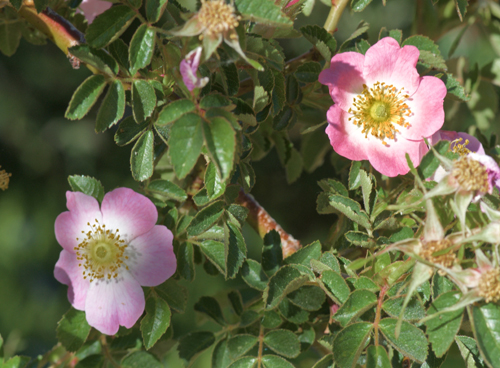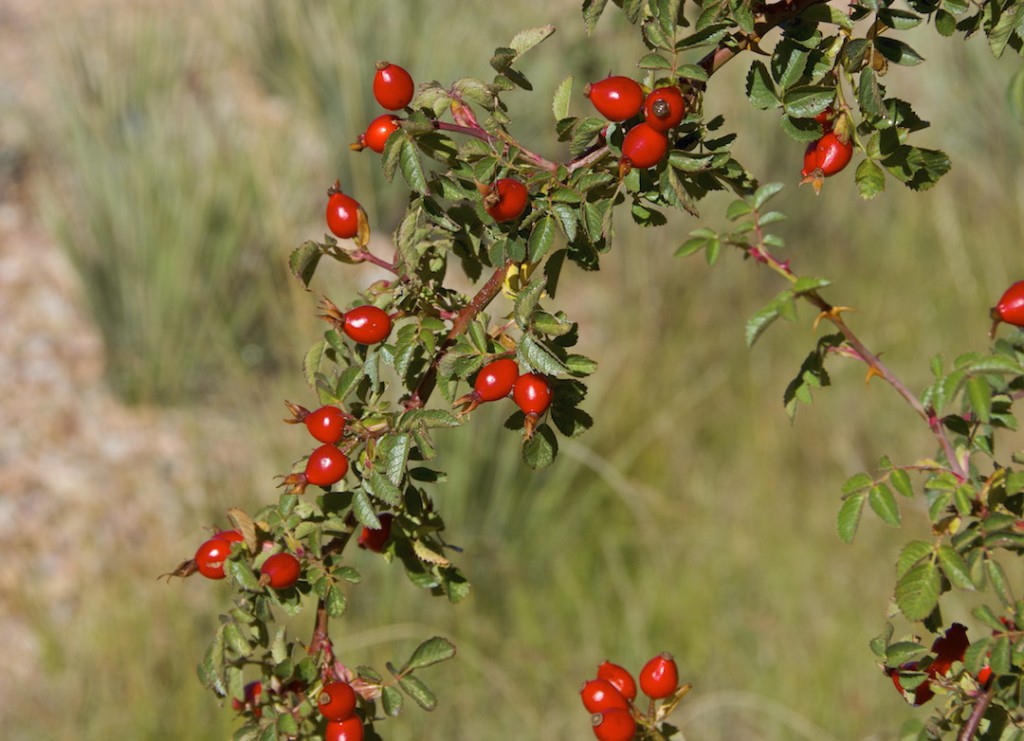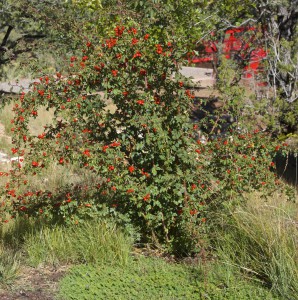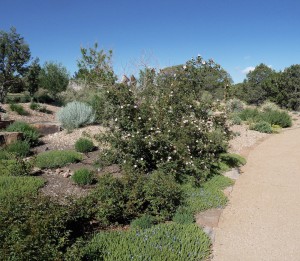Scientific Name: Rosa rubiginosa

Sweet briar rose flowers (Photo: Janice Tucker)
Synonym: Rosa eglanteria
Family: Rosaceae
Common Name: sweet briar rose or rose ‘Eglantine’
Article by Jeanne Gozigian
Gertrude Stein famously said, “A rose is a rose is a rose.” Ah, but the marvelous, beloved, diverse, and prolific Rose family is anything but that simple! There are 100-150 species roses; that is, roses that occur in the wild with no human intervention. And there are countless numbers, in the thousands, of roses that have been hybridized to create what people want to have in their gardens, greenhouses, conservatories, and wedding bouquets.
The sweet briar rose is a species rose, native to Europe and West Asia, which has naturalized in North America. Like most species roses, it is light pink, has five petals in single blossom form and blooms once in spring or summer, although may have an occasional repeat flowering. The foliage has a strong apple scent after rain and when crushed between fingers. Yes, the incredible Rose family includes all apples as well as strawberries, raspberries and blackberries. Sweet briar is very disease resistant, as are wild berries.

Rosa rubiginosa hips (Photo: Janice Tucker)
An outstanding feature of sweet briar is the showy red hips that it produces after the blossoms fade. Rose hips are a natural source of vitamin C; they were actually used by World War II British troops to supply this crucially needed supplement. A one-cup infusion provided the daily allowance. In Spain and Argentina, rosa mosqueta, common name used there, is used to make marmalade and cosmetic products.
It is suggested that R. rubiginosa be planted in full sun, with well-drained loamy soil. Hey, come on, this is a wild rose that has been making it on its own! Of course, it will do better if well treated. It thrives in zones 4-9 and will reach 6-10 feet in height and width. Because of its extreme thorniness, it makes a formidable barrier hedge. It is self-fertile and also pollinated by bees and butterflies. There is a gall wasp that is very attracted to it and makes nodules on the stems. They are not harmful to the plant. Rubiginosa (roo-bij-ih-NO-suh) means “rusty”, and eglanteria (eg-lan-TER-ee-uh) is from aiglant, the old French name for sweet briar, according to Botanary, the Botanical Dictionary.

Rosa rubiginosa bush (Photo: Janice Tucker)
R. rubiginosa is considered invasive in southwest Australia and New Zealand. It has been restricted for planting. It makes me wonder if there is a close relationship between R. rubiginosa and Rosa woodsii, a common Rocky Mountain wild species rose. They both send out sturdy suckers and tend to take over garden space. I made the mistake of saving R. woodsii that came as a bonus with aspen trees we planted in our new landscape, and requires some constant cutting back of suckers which grow large quickly in improved, rich soils and irrigated garden situations. But I love the sweet pink blossoms that are the first roses of spring. I first encountered it when hiking mountain trails when I was new to New Mexico and was so surprised to see the beautiful pink rose growing in the wild.
Roses are the flowers of love in almost all cultures. Countless examples are there to be seen in poetry:
Shakespeare – “a Midsummer-Night’s Dream”, Oberon on Titania’s bower:
I know a bank where the wild thyme blows,
Where oxlips and the nodding violet grows;
Quite over-canopied with luscious woodbine,
With sweet musk roses and with eglantine.
Then there is Bobby Burns:
My luve is like a red, red rose…
Till a’ the seas gang dry, my dear…
I will luve thee still.
Perhaps the rose has come to symbolize love because of its beauty, fragrance, and idea of purity associated with the Holy Mother. And maybe because of the danger of its thorns! Of course, the rose was probably the first flower to be used to produce perfumes. If all of this weren’t enough, rose hip oil, pressed from mature hips, is widely used in skin care products. It is high in beta-carotene and absorbs easily, so is said to be useful for hydration of the skin, healing of scars, and to alleviate aging.
For whatever reason, let us celebrate the Rose family!

Rosa rubiginosa at Botanical Garden at Museum Hill (Photo: Janice Tucker)
At the Santa Fe Botanical Garden at Museum Hill, the sweet briar rose is located along the rose and lavender walk and north of the orchard.
Sources:
- Queensland Government website
- swcoloradowildflowers.com
- plants.usda.gov
- sfbotanicalgarden.org, plant website
- helpmefind.com, HelpMeFind: Roses, Clematis, and Peonies
- American Meadows website
- Botanary, the Botanical Dictionary
- Right Rose Right Place by Peter Schneider
- Wikipedia


